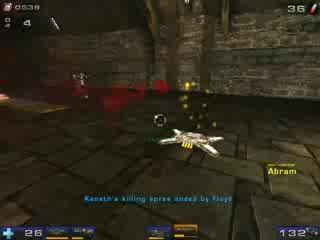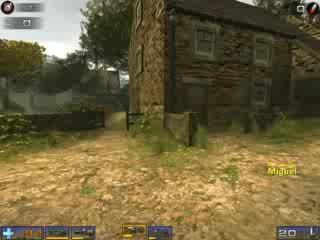"When this 'Turing test for game bots' competition was started, the goal was 50 percent humanness," said Miikkulainen. "It took us five years to get there, but that level was finally reached last week, and it's not a fluke."
The complex gameplay and 3-D environments of "Unreal Tournament 2004" require that bots mimic humans in a number of ways, including moving around in 3-D space, engaging in chaotic combat against multiple opponents and reasoning about the best strategy at any given point in the game. Even displays of distinctively human irrational behavior can, in some cases, be emulated.
"People tend to tenaciously pursue specific opponents without regard for optimality," said Schrum. "When humans have a grudge, they'll chase after an enemy even when it's not in their interests. We can mimic that behavior."
In order to most convincingly mimic as much of the range of human behavior as possible, the team takes a two-pronged approach. Some behavior is modeled directly on previously observed human behavior, while the central battle behaviors are developed through a process called neuroevolution, which runs artificially intelligent neural networks through a survival-of-the-fittest gauntlet that is modeled on the biological process of evolution.
Networks that thrive in a given environment are kept, and the less fit are thrown away. The holes in the population are filled by copies of the fit ones and by their "offspring," which are created by randomly modifying (mutating) the survivors. The simulation is run for as many generations as are necessary for networks to emerge that have evolved the desired behavior.
"In the case of the BotPrize," said Schrum, "a great deal of the challenge is in defining what 'human-like' is, and then setting constraints upon the neural networks so that they evolve toward that behavior.
"If we just set the goal as eliminating one's enemies, a bot will evolve toward having perfect aim, which is not very human-like. So we impose constraints on the bot's aim, such that rapid movements and long distances decrease accuracy. By evolving for good performance under such behavioral constraints, the bot's skill is optimized within human limitations, resulting in behavior that is good but still human-like."
Miikkulainen said that methods developed for the BotPrize competition should eventually be useful not just in developing games that are more entertaining, but also in creating virtual training environments that are more realistic, and even in building robots that interact with humans in more pleasant and effective ways.

Under heavy fire from a human judge, UT^2 manages to fight his way to a nearby weapon and obliterate his opponent.
(Photo Credit: Courtesy of Jacob Schrum)

UT^2 game bot faces off against an opponent.
(Photo Credit: Courtesy of Jacob Schrum)

This is a combat clip, which is seen from the perspective of a human judge (whose game name is Miguel) as he's killed by the UT^2 game bot (game name Ty).
(Photo Credit: Courtesy of Jacob Schrum)
Source: University of Texas at Austin